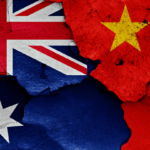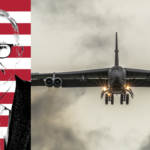US Escalates Its Militarisation of Australia, Under Albanese

Foreign minister Penny Wong’s end of year trip to Beijing to meet with her Chinese counterpart Wang Yi was hailed as an indication that the recently fraught relationship between the two nations was stabilising, especially in terms of the potential to ease sanctions that have long impeded trade.
However, a fortnight earlier, Wong had been in Washington DC to attend the 6 December AUSMIN conference, where her nation and the US noted their joint determination to “counter destabilising military activities by the People’s Republic of China”.
The annual Australia US Ministerial consultation additionally saw the two nation’s deepen their defence cooperation in a number of ways, which include the United States increasing the number of troops it rotates through Australian military bases in the north of the country.
In a further sign that Wong’s trip to China, the first such visit by an Australian foreign minister since 2018, wasn’t such a sincere extension of the olive branch last month’s AUSMIN participants also announced that they’ve invited Japan to integrate into US military operations in Australia.
So, while the Albanese government has pulled back on the overt China rhetoric of its predecessor, and it’s repairing the COVID-era trade breakdown with Beijing, it continues to provide the US with unfettered access to bases with the associations that carries regarding regional military build-up.
Ever-increasing deployment
The AUSMIN consultations began in 1985. Last year’s instalment saw Wong and defence minister Richard Marles meet with US secretary of state Antony Blinken and defence secretary Lloyd Austin in the US capital in early December.
During the AUSMIN press conference, Austin stated that an invitation was being extended to Japan, a QUAD partner, to join in the US Force Posture Initiatives (USFPI) on Australian soil, which comprise of the Marine Rotational Force-Darwin (MRF-D) and the Enhanced Air Cooperation (EAC).
“We look forward to being able to have more engagement with Japan in terms of that force posture cooperation,” reiterated Marles. The Australian deputy PM also added that he and Wong were going to formally extend the invite to Japan to join in extra military exercises at a meeting later that week.
The MRF-D initially saw 200 US military personnel rotated through northern Australia during the dry season in 2012. And that number had risen to 2,500 by 2019. And with the commencement of the EAC in 2017, efforts are being made to enhance Australian and US air force interoperability.
“Based upon today’s talks, we will increase rotational presence of US forces in Australia,” Austin explained in relation to the USFPI. “That includes rotations of bomber task forces, fighters, and future rotations of US navy and US army capabilities.”
The AUSMIN commitments came just a month after it came to light that the US upgrade of the RAAF Base Tindal, located south of Darwin, will include a parking apron to accommodate six nuclear-capable US B-52 fighters, which are being strategically positioned in relation to China.
Access all areas
Blinken opened the recent AUSMIN press conference by citing the ANZUS treaty of seventy years ago. He asserted that this kicked off the work that his nation and ours have been carrying out in relation to strengthening “the fabric of peace in the Pacific” ever since.
However, as veteran journalist Brian Toohey outlines in 2019’s Secret, while the 1951 Australia New Zealand US Security (ANZUS) treaty does commit us to nonaggression, it doesn’t bind any party to support another in entering a conflict and nor does it make allowances for local US deployments.
Rather it was an agreement made between the Gillard government and the Obama administration in 2012 that lead to the US Force Posture Initiatives that were then formalised under the 2014 Force Posture Agreement (the FPA) between this country and the United States, which lasts for 25 years.
The FPA establishes a number of agreed facilities and areas in Australia that it’s been established US forces and contractors are permitted unimpeded access to, as well as their having the ability to take operational control of such facilities in the circumstances of upgrading them.
Activities that are open to US troops to engage in at such facilities, include training, transit, support, the stationing and maintenance of vehicles, vessels and aircraft, temporary accommodation, communications, equipment storage and deployment of forces.
As Independent and Peaceful Australia Network (IPAN) spokesperson Dr Vince Scappatura explained in a recent press release, the Australian government committed the nation to being used as a US base in the Indo-Pacific region at a time of rising tensions, with no consultation with the public.
“Australia has bent over backwards to accommodate greater rotations of all types of US military forces, including multi-billion-dollar defence facility upgrades to base more lethal US power-projection elements, such as… six nuclear-capable B-52 bombers,” he added.
Indeed, as opposed to ANZUS, which has long been wrongly understood to require the US to support an Australia under attack, and the widely spruiked AUKUS pact the Morrison government embroiled us in two years back, the FPA has continued to operate under the radar since 2014.
Bridging the gap
The Morrison government announced in mid-September 2021, that the nation had entered into the AUKUS (Australia, UK and US) pact, which involves our country acquiring eight nuclear-powered submarines that pose a direct threat to China.
There was, again, no consultation with the Australian public, despite the nuclear implications, and the details of the agreement remain sketchy at best.
The Australian deputy prime minister raised the AUKUS at the recent AUSMIN conference, outlining that the most important capability that our nation is currently focused on obtaining is the nuclear-powered submarine, which will “transform Australia’s strategic posture”.
However, the fact that Australia might experience a capabilities gap as the submarines aren’t likely to come onboard until the 2030s was put to US defence secretary Austin during questions that were asked at the end of the conference.
“We recognise where Australia is and how – when its capability begins to diminish, and, of course, we will address all of that in that pathway that we create,” Austin said in response to the question. “And so, we will not allow Australia to have a capability gap going forward.”







